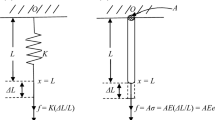Abstract
The mechanisms that draw, accumulate, or transport chemical fibres act on their movement and stress-strain state with normal and frictional forces of interaction between fibres and the cylinders of the mechanisms. The auxiliary problem of determining the parameters characterizing the interaction between one of the cylinders in a mechanism and the part of the fibre abutting it is solved here. The solution of the problem was constructed by the small-parameter method, where the friction coefficient of the fibre against the cylinder was used as the parameter. The spatial position of the fibre, velocity of its particles, and tension in each cross section were determined in zeroth and first-order approximations.
Similar content being viewed by others
REFERENCES
V. A. Chaikin, Khim. Volokna, No. 5, 63-66 (2000).
N. I. Alekseev, Statics and Steady-state Movement of a Flexible Fibre[in Russian], Legkaya Industriya, Moscow (1970).
Yu. V. Yakubovskii, V. S. Zhivoy, et al., Principles of Fibre Mechanics[in Russian], Legkaya Industriya, Moscow (1973).
M. A. Krasnosel'skii, G. M. Vainikko, et al., Approximate Solution of Operational Equations[in Russian], Nauka, Moscow (1969).
Author information
Authors and Affiliations
Rights and permissions
About this article
Cite this article
Chaikin, V.A. Calculation of Frictional Forces in the Theory of Fibre Tension Accumulation and Transport Mechanisms. Fibre Chemistry 33, 73–77 (2001). https://doi.org/10.1023/A:1019294017502
Issue Date:
DOI: https://doi.org/10.1023/A:1019294017502




